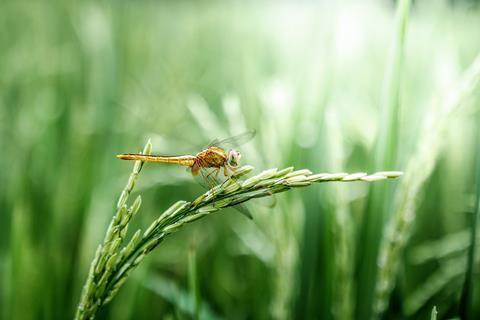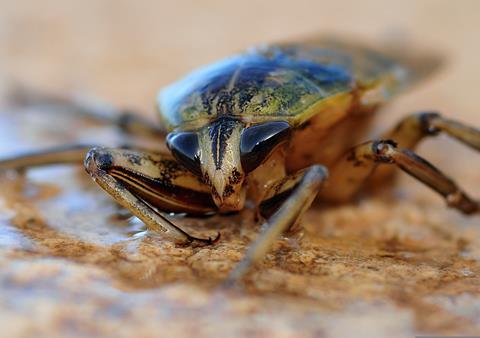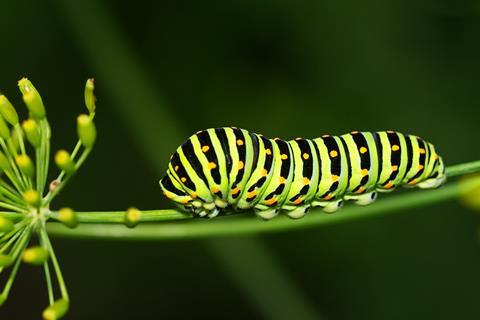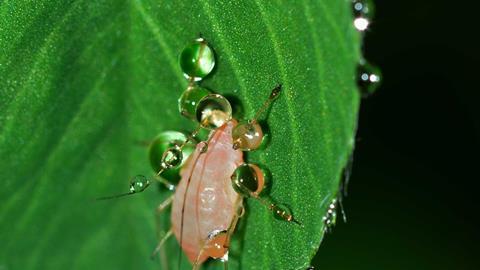Microbial interactions encompass organisms’ effects that impact other populations. However, not all are mutually beneficial, and some have negative impacts. Many researchers are increasingly interested in applying microbial interactions to pest control. Work in this area has uncovered fascinating conclusions. Additionally, broader work in this area may reveal insights that could further pest control-related successes.
Discovering how the squash bug acquires a gut bacterium
Scientists familiar with squash bugs know that these creatures have a particular type of bacteria in their guts that is essential for their development into adults. But squash bugs do not have it when hatching. How do they end up with it?
Emory University graduate student Jason Chen stumbled upon a clue while cleaning up the research lab. He noticed that squash bug nymphs had flocked around a spot left by adult squash bugs’ faecal matter. After developing, those bugs had gut bacteria that Chen had tagged with a red fluorescent protein. After examining the nymphs under the microscope, he found they had acquired the same bacteria only after they ate the adult faecal matter.
This discovery allowed Chen to conclude that the nymphs must eat the adults’ faecal matter to receive the essential bacteria that enable their development. He clarified the mechanisms of this microbial interaction by mentioning that young bugs must locate a particular microbe to continue healthy growth. They find it in the faeces of adults of the same species.

Although substantial research concerns the human gut microbiome, some scientists note that the insect microbiome is comparatively easier to study because it is less complex. That characteristic makes them ideal to study in laboratory settings, especially when researchers want to learn more about host-microbe interactions.
As their name suggests, squash bugs target squash plants, with pumpkin plants also at risk from their infestation. They also sometimes affect other gourd-family plants, such as cucumbers and watermelon. Besides directly damaging these crops, infestation can also spread a pathogen that causes yellow vine disease.
Additionally, this study gave researchers new insights into squash bug behaviours.
Engineering plant microbiomes for better protection
Plants contain massive amounts of microorganisms in their roots, including viruses, bacteria and fungi. They cause positive microbial interactions, making the plants more resilient against diseases and pests. Researchers from the University of Southampton wondered if they could increase pest protection with internal tweaks.
They achieved a world first by altering plants’ microbiomes, boosting the quantity of beneficial bacteria. The hope was that this change would make them more resilient against harmful bacteria. Then, farmers might be able to reduce the use of pesticides known to harm the environment.
Although the group applied this strategy to rice crops, they created a framework believed to be applicable to other plants. Additionally, the team said they could cause other outcomes by changing the quantities of different microbes. For example, increasing those that provide nutrients to crops could reduce dependence on chemical fertilisers but still allow farmers to achieve excellent yields.
The researchers determined a single gene associated with the lignin biosynthesis cluster in rice plants influenced its microbiome composition. More specifically, when the scientists deactivated that gene, the population sizes of specific beneficial bacteria decreased. Next, they caused gene overexpression of a particular metabolite. Rice plants produce this small molecule during their metabolic processes. Increasing it caused a proportional rise in the beneficial bacteria within the microbiome.
They also found a strong link between the plant’s genotype and members of four bacterial orders, confirming that some associations are related to specific pathways or genes.

The need to find pesticide alternatives
People dealing with pest problems do not usually consider the long-term and broader effects. For example, someone faced with a cockroach infestation wants to tackle the immediate issue and may not consider how using their chosen pesticide could make the insects more resistant to others’ future efforts to control them.
Cockroaches have gradually evolved, making many commercial and widely used pesticides less effective. Thus, the companies selling those products must continually invest in research and development, enabling scientists to uncover new formulas that will likely work better.
Cockroaches have existed for approximately 140 million years, much longer than humans. That long time frame results in a lengthy evolutionary history, making the insects harder to kill. One research team also theorised that the popularity of pesticides as a control method has resulted in those products being less effective over time. They studied German cockroaches and their reactions to gel bait insecticides, which are some of the most commonly used in the United States.
Their research occurred in Southern California, where the group collected hundreds of roaches from areas where residents generally cannot afford professional pest control. There, people are more likely to use store-bought products to address the matter. However, the group found that tendency creates a feedback loop.

Cockroaches’ greater exposure to over-the-counter products creates more opportunities for them to evolve and resist them. Experiments showed that the roaches exposed to insecticides in five of six trials survived for at least two weeks. Although one product effectively killed the cockroaches, the researchers believe future versions could evolve to resist it, which would only take approximately one year. This outcome emphasises the need to find alternatives, including continuing to study microbial interactions.
How breeding can curb crops’ defences
Some microbial interactions naturally help plants defend themselves against the threats they are most likely to encounter. However, researchers determined that the commercial breeding efforts that cater to people’s preferences for certain foods can compromise those internal defences.
Researchers examined volatile organic compounds (VOCs), which plants naturally produce to interact with the surrounding environment. Additionally, the team focused on tomato crops and their responses to caterpillars and fungi.
Plants use VOCs to communicate with each other, sending out chemical signals to warn of danger. Since moving away from the threat is impossible, the best strategy is to raise awareness. However, VOCs do more, including recruiting beneficial soil microbes that help plants grow. This is an example of a helpful microbial interaction that increases the likelihood of healthy development.
Additionally, when a tomato plant detects a caterpillar chewing on its leaves, it sends out a VOC that tells the insect’s predators where to find it. This communication method then becomes a natural pest safeguard. The researchers also found that various factors — such as the tomato plant variety, its exposure to caterpillars and the presence of particular soil microbes — can affect VOC profiles. Their analyses detected 21 volatiles but indicated the tomato type strongly determined the extent of the respective emissions.
The group studied two heirloom tomatoes and two hybrids, finding that the latter types emitted fewer VOCs than their counterparts. Moreover, exposure to arbuscular mycorrhizal fungi decreased the VOCs in all varieties. However, the fungi benefited the tomatoes by causing higher leaf biomass and giving them more complex root structures.
The reduced VOC output in the hybrids illustrated that conventional breeding could affect plants’ natural defences. In such cases, farmers may need to apply more pesticides to compensate.

Learning more about a sticky substance that traps pests
In another tomato-related discovery, researchers found that the plant’s roots contain metabolites called acylsugars. They create a sticky substance on tomato plants’ leaves, turning them into something resembling flypaper to catch pests. However, until this study showed otherwise, scientists believed trichomes — the fine, hairy outgrowths on some above-ground plant tissues — exclusively contained acylsugars.
Additionally, the researchers determined that tomato plants chemically synthesise unique acylsugars in their roots and trichomes, and production occurs within two parallel metabolic pathways that never interact. This investigation involved studying the acylsugars in tomato seedlings’ roots and shoots to quantify the differences. The results indicated that the metabolites in the above and below-ground parts of the plant were so dissimilar that scientists could put them in two different classes.
Moreover, this research revealed that disrupting the acylsugar gene in one of the pathways did not affect activity in the other, allowing production to continue in these separate sugar cores. The researchers clarified that acylsugars act as natural pesticides for tomato plants. These discoveries could illuminate other new pest control strategies affecting tomatoes or additional crops. For example, if people could breed acylsugars into other plants, that approach could significantly reduce dependence on conventional pesticides, allowing nature to do more of the work.
Some of these scientific revelations spanned beyond metabolites, too. The group realised something surprising about biosynthetic gene clusters (BGC), which contribute to specific metabolic pathways. Although BGCs usually appear in the same tissues and under similar conditions, these were separate but interlinked, with some appearing in the tomatoes’ trichomes and others in their roots. Even though tomatoes are widely grown and studied, these results highlight how there is always more to learn.

Conclusion
Scientists have found well-established links between pesticide use and ecosystem disruption. One of the main issues is that these products can harm non-targeted organisms. Water runoff can also broaden the impacts of pesticide applications, potentially harming living things far from where people initially used these products.
These cons are in addition to complementing research showing that pests can adapt to products, making them less harmful over time. Then, people may need to apply larger quantities of products to get the effects they once achieved. Alternatively, they may choose to try different brands or chemicals. However, researchers know insects can evolve quickly to allow surviving exposure to pesticides, creating a seemingly never-ending cycle.
That being said, many plant researchers view microbial interactions as a source of optimism. Learning about natural pest defences could result in new product formulations or encourage scientists to keep exploring the genetic and microbe-related particulars that help crops fight against infestations.
Challenges remain, especially as research teams investigate the most feasible ways to apply their knowledge to mass-scale agriculture. Succeeding might mean finding corporate partners or running numerous real-world trials to show businesspeople and potential investors that microbial interactions could prove vital to fighting pests in new, more sustainable ways.








No comments yet